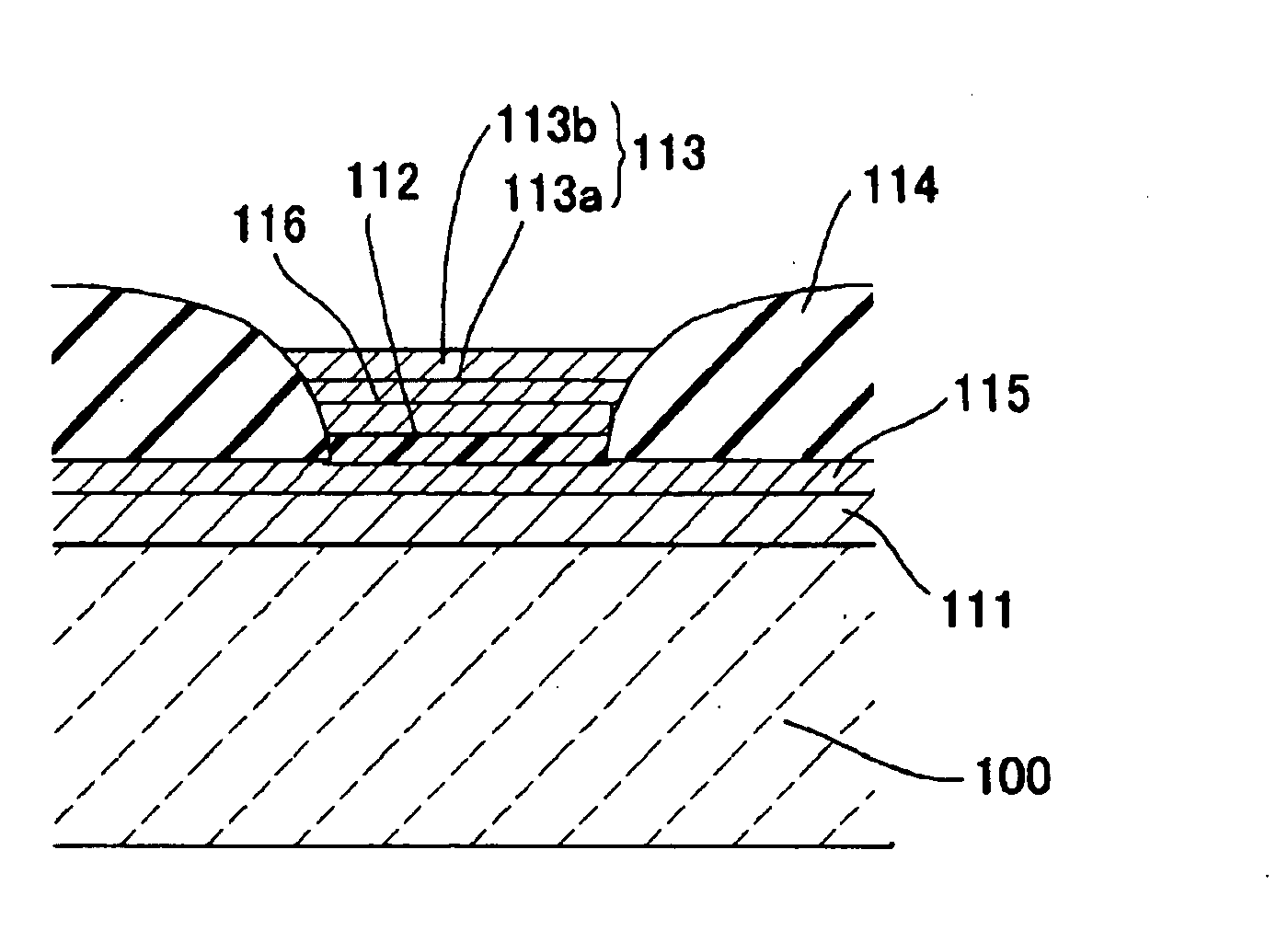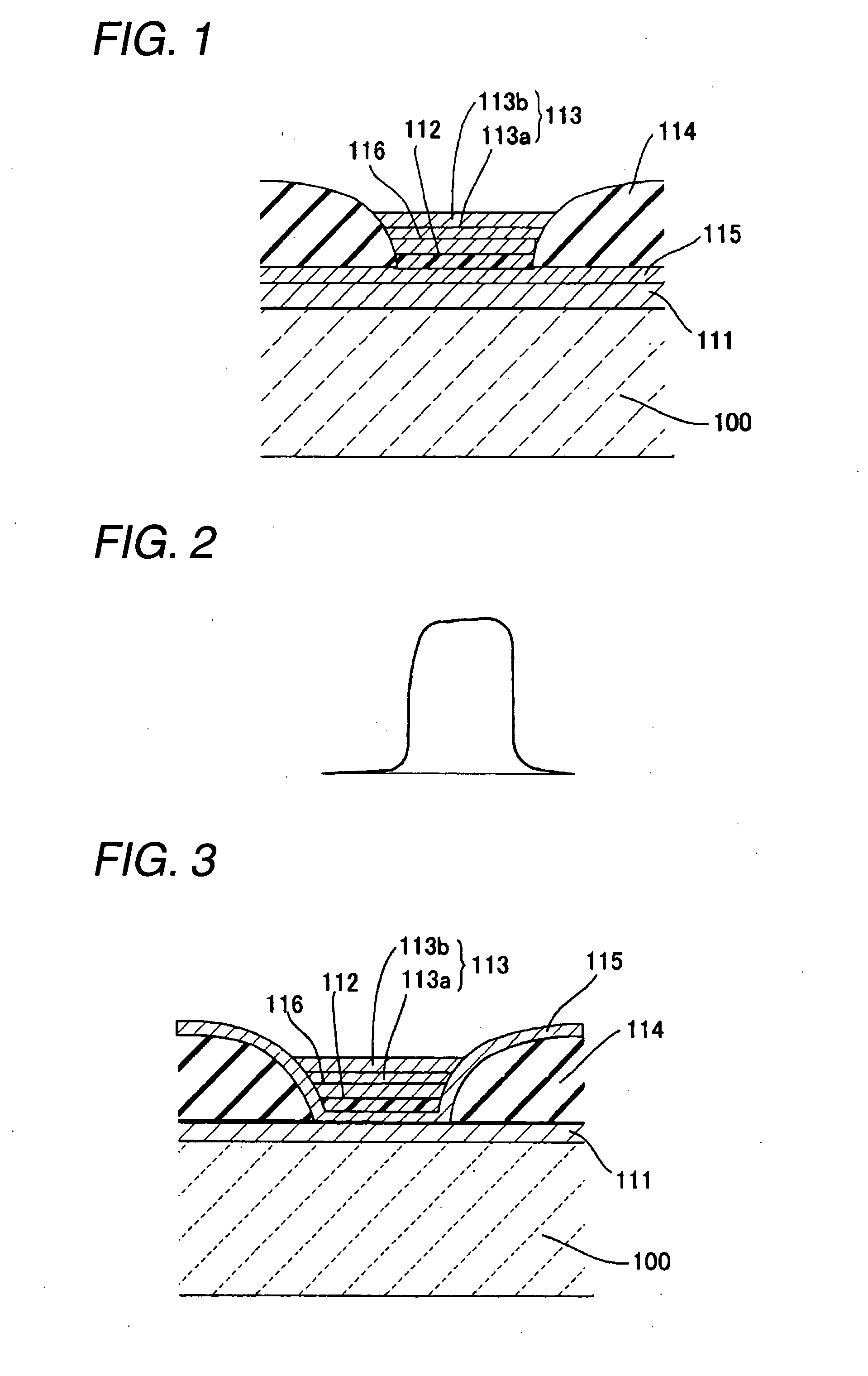Organic electroluminescent element, and manufacturing method thereof, as well as display device and exposure apparatus using the same
- Summary
- Abstract
- Description
- Claims
- Application Information
AI Technical Summary
Benefits of technology
Problems solved by technology
Method used
Image
Examples
first embodiment
[0046]FIG. 1 is a block diagram illustrating an organic electroluminescent element of a first embodiment of the present invention.
[0047]As illustrated in FIG. 1, the organic electroluminescent element of the first embodiment is constituted with a substrate 100 based on a translucent glass, ITO (indium tin oxide) as a positive electrode 111 formed on the substrate 100, a transition metal oxide thin film (molybdenum oxide layer) as a charge-injection layer 115 additionally formed on the upper layer thereof, a luminescent layer 112 composed of a polymer material, a transition metal oxide thin film (molybdenum oxide layer) as a buffer layer 116, an intermediate layer 113a composed of Ba, Ca and the like, and an electrode layer 113b formed with a metal material such as Ag, Al, Mg or In (the intermediate layer 113a and the electrode layer 113b are collectively referred to as a negative electrode 113).
[0048]As described above, the organic electroluminescent element of the first embodiment ...
second embodiment
[0237]FIG. 15 is a sectional view showing a constitution of an organic electroluminescent element used in an exposure apparatus of an image forming device of a second embodiment of the present invention.
[0238]In the second embodiment, a detailed description will be made for the thickness of a transition metal oxide as the charge-injection layer 115 described in the first embodiment and a specific resistance value.
[0239]An electroluminescent element of the second embodiment is provided with a positive electrode 111 composed of ITO, a negative electrode 113 constituted, for example, with a metal and a functional layer formed between these electrodes on a translucent substrate 100. These functional layers are provided with a luminescent layer 112, that is, a luminescence function at least composed of an organic semiconductor polymer layer.
[0240]It is also provided with a transition metal oxide layer (specifically, 40 nm-thick molybdenum oxide layer) as the charge-injection layer 115 be...
third embodiment
[0267]Hereinafter, a description will be given of a third embodiment with reference to drawings.
[0268]FIG. 16 is a sectional view showing an organic electroluminescent element of the third embodiment of the present invention. This electroluminescent element is provided with a positive electrode 111 composed of an ITO layer as a first electrode, a negative electrode 113 as a second electrode and a functional layer formed between these electrodes on a translucent substrate 100, in which the functional layer is provided with a luminescent layer 112, that is, a layer having the luminescence function composed of an organic semiconductor polymer layer, a 40 nm-thick transition metal oxide layer as the charge-injection layer 115 formed between the positive electrode 111 and the luminescent layer 112 (molybdenum oxide layer, hereinafter, referred to as transition metal oxide layer 115), a pixel restricting layer 114 composed of a 50 nm-thick silicon nitride film on the upper layer thereof, ...
PUM
 Login to View More
Login to View More Abstract
Description
Claims
Application Information
 Login to View More
Login to View More - R&D
- Intellectual Property
- Life Sciences
- Materials
- Tech Scout
- Unparalleled Data Quality
- Higher Quality Content
- 60% Fewer Hallucinations
Browse by: Latest US Patents, China's latest patents, Technical Efficacy Thesaurus, Application Domain, Technology Topic, Popular Technical Reports.
© 2025 PatSnap. All rights reserved.Legal|Privacy policy|Modern Slavery Act Transparency Statement|Sitemap|About US| Contact US: help@patsnap.com



